|
|
|
Sort Order |
|
|
|
Items / Page
|
|
|
|
|
|
|
| Srl | Item |
| 1 |
ID:
169919
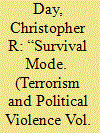

|
|
|
|
|
| Summary/Abstract |
To date, scholarly work on armed groups has seldom considered the notion of rebel resilience, or the factors that enable these groups to survive despite time, military pressure, and the myriad contingent events of civil war. In an effort to develop an explanatory framework for resilience as a distinct outcome of civil war and rebellion, this article examines the conditions under which the Lord’s Resistance Army (LRA) has persisted for nearly three decades. Based on fieldwork and original research, the article explains the LRA’s resilience in light of the group’s organizational structure and resource self-sufficiency, which have been well suited for the borderlands of East and Central Africa. The LRA is a key case of rebel resilience. It is important because it sheds light on the organizational foundations of armed groups, the relationship between resources and rebellion, and the broader study of conflict duration and termination. Understanding the sources of the LRA’s resilience can inform efforts to end such insurgencies.
|
|
|
|
|
|
|
|
|
|
|
|
|
|
|
|
| 2 |
ID:
169928
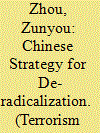

|
|
|
|
|
| Summary/Abstract |
China is fighting a tough battle against separatist terrorism perpetrated by militant Muslim Uyghurs in the far-western region of Xinjiang. De-radicalization is one of the policies the authorities in Xinjiang have recently taken to address the upsurge in terrorist violence. This paper consists of five parts. The first part deals with the background against which the de-radicalization strategy was conceived and developed. The second part discusses several major approaches to the strategy such as “five keys,” “four prongs,” “three contingents,” “two hands,” and “one rule.” The third part presents custodial, post-imprisonment, and social programs for targeting three groups of people: imprisoned radicals, released radicals, as well as those who are radicalized but not prosecuted. The fourth part describes programs for engaging communities in order to win over politically reliable people from civil society for support in de-radicalization. The last part draws a conclusion regarding the characteristics of, effectiveness of, controversies over, and future of the Chinese de-radicalization campaign.
|
|
|
|
|
|
|
|
|
|
|
|
|
|
|
|
| 3 |
ID:
169916


|
|
|
|
|
| Summary/Abstract |
Historians of terrorism note that modern terrorists rely almost exclusively on two weapon types: the gun and the bomb. However, the comparative use of these weapons differs from one terrorist group to the next. We exploit this variation to examine how the tactical decisions of terrorists respond to both strategic aspirations and resource constraints. We argue that a group’s goals (a strategic consideration) and size (a resource constraint) provide a parsimonious explanation for weapon selection. Because firearms inherently expose the shooter to higher risk, are more precise, and must be used if a group aspires to maintain social order, they are unlikely to be used by groups with limited recruits in a campaign of violence. We test this theory using data on over 350 terrorist organizations. Our analysis shows that strategic considerations and resource constraints both impact tactical choices, although groups with the most expansive goals, those which transcend national borders, as well as militias, are two interesting exceptions to our theory. Our research has implications for the use of disaggregated tactical data and in furthering our understanding of the rationality of terrorism.
|
|
|
|
|
|
|
|
|
|
|
|
|
|
|
|
| 4 |
ID:
169918


|
|
|
|
|
| Summary/Abstract |
This study explores differences in perpetrators of suicide attacks and non-suicide attacks in the United States. The study uses data on far-right and Al Qaeda and affiliated/inspired terrorists between 1990 and 2013 from the United States Extremist Crime Database. Our analysis estimates logistic regression models to test whether suicide attackers were more likely to have exhibited specific risk factors for suicidality, while examining other prominent claims regarding patterns of suicide terrorism. Suicide attackers were no more likely than non-suicide attackers to have previously attempted suicide or to have been diagnosed as mentally ill. Suicide attackers were more likely, though, to have a history of substance abuse, to be loners, have served in the military, participated in paramilitary training, and be more ideologically committed to the cause. We found that Al Qaeda affiliated/inspired attackers were more likely than far-right attackers to have engaged in a suicide mission. With the current focus on Americans traveling to Syria and Iraq to receive training and fight for jihadist movements (e.g., the Islamic State), our findings appear relevant. Observers have expressed concern that these fighters may return and then commit attacks in their homeland. Law enforcement could make use of this study’s findings.
|
|
|
|
|
|
|
|
|
|
|
|
|
|
|
|
| 5 |
ID:
169926
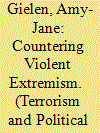

|
|
|
|
|
| Summary/Abstract |
Scientific knowledge on what works in countering violent extremism remains limited. This article argues that we should move away from the “what works?” question and towards: “what works, for whom, in what circumstances, and how?” This method is also known as realist evaluation. This article applies the realist review method to CVE studies, which synthesizes the existing CVE literature and helps us gain insight into relevant contexts, mechanisms, and outcomes for CVE. Realist reviews help to develop and shape more effective policy and contribute to further CVE theory development.
|
|
|
|
|
|
|
|
|
|
|
|
|
|
|
|
| 6 |
ID:
169932
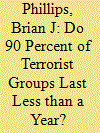

|
|
|
|
|
| Summary/Abstract |
Prominent scholars criticize terrorism research for lacking sufficient empirical testing of arguments. Interestingly, one of the most widely cited estimates in terrorism studies has not been evaluated using the many data sources now available. Rapoport’s 1992 claim, that perhaps 90 percent of terrorist groups last less than one year, has been described as part of the conventional wisdom. This estimate is frequently used to justify studies of terrorist group longevity, a substantial line of research in recent years. Is the estimate accurate? Scholars increasingly publish data sets of terrorist organizations, but no one has analyzed them collectively to see if the 90 percent claim holds up. This article examines the eight largest global data sets of terrorist group longevity, covering 1968–2013. The samples vary considerably, but the percentage of groups that do not survive beyond their first year in these relevant data sets is between 25–74 percent. Across all data sets, on average about 50 percent of terrorist organizations do not make it past their first year. There is some variation depending on group motivations, consistent with Rapoport’s “wave” theory. However, overall, terrorist organizations appear to be more durable than the conventional wisdom suggests.
|
|
|
|
|
|
|
|
|
|
|
|
|
|
|
|
| 7 |
ID:
169913
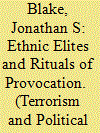

|
|
|
|
|
| Summary/Abstract |
Prominent theories of ethnic conflict argue that instrumental ethnic elites incite violence in order to promote their own power. Yet this approach focuses primarily on political leaders and ignores other ethnic elites, meaning that we know little about how other influential actors think about provocation. In this paper, I present novel data from Northern Ireland on diverse elite attitudes toward polarising Protestant parades with a long history of sparking ethnic violence. Using original surveys of Protestant elected officials and clergy as well as interviews with ex-paramilitaries, this paper demonstrates that these elite groups have different, often competing, interests and opinions regarding contested parades: while politicians tend to support provocative parades, the others do not. By addressing elite actors that are often ignored, I present a more nuanced picture of elite-mass relations and ethnic mobilisation in conflict.
|
|
|
|
|
|
|
|
|
|
|
|
|
|
|
|
| 8 |
ID:
169936


|
|
|
|
|
| Summary/Abstract |
Utilizing a sample drawn to represent the general U.S. population, the present study experimentally tested whether a call-center’s disclaimer regarding limits to caller confidentiality (i.e., that operators would be required to refer calls to law enforcement if callers were to discuss anyone who was a danger to themselves or others) affected disclosures related to a third party’s involvement with terrorist groups, gangs, or such party’s commission of assault and/or non-violent crimes.
|
|
|
|
|
|
|
|
|
|
|
|
|
|
|
|
| 9 |
ID:
169929
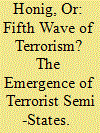

|
|
|
|
|
| Summary/Abstract |
Drawing on Rapoport’s four waves thesis, this study asks whether the emergence of terrorist semi-states (TSS) in the 21st-century MENA region and Pakistan mean that we are seeing the beginning of a new (fifth) wave. We define a TSS as a rebel group that a) has control over portions of a weak state’s territory, maintaining governance there; b) but still launches terrorist attacks against third-party states. To be considered a fifth wave, the new terrorism phenomenon at hand must both fit Rapoport’s criteria of a wave (be global, have the same driving force) and also be significantly different from the prior wave. Clearly, the TSSs are different from the religious terror groups of the fourth wave in key respects: they prioritize territorial control, they engage in a much wider array of governance activities (not just social services), most of their victims have been members of the same religion—namely, Muslims (which suggests that they are driven more by the pursuit of power than by Jihad); and finally, their behavior (though not their statements) shows they have a local rather than a universal agenda. The main counter-argument is that TSSs are all Islamic and have so far not been exported globally.
|
|
|
|
|
|
|
|
|
|
|
|
|
|
|
|
| 10 |
ID:
169930


|
|
|
|
|
| Summary/Abstract |
Between the 18th and 26th of November 2016, 220 different locations went up in flames in the Israeli forest. Israeli firefighters were powerless to contain the fires, so army and police units had to contribute. Thousands of civilian volunteers also joined the fight against the fire. The Israeli firemen were unable to curb the continuously blazing fires, which is why the Prime Minister, Benjamin Netanyahu, asked and received international support. The operation lasted for eight days, more than 1,700 fires were eliminated, but the conflagration caused considerable damage. Due to the extremely dry and windy periods, many blamed the weather conditions for the damage, but it soon became clear that in several cases, the cause was arson. Although arson as a method of extremism has been continuously practiced in many incidents worldwide, it is still beyond the scope of research on terrorism. This essay aims to prove that we have to raise awareness of the issue, highlighting both relevant incidents and the extremist group’s propaganda incentive towards the enhanced use of arson. We raise the question whether on the basis of the incidents in Israel, arson could become a frequently used method of European terrorist units or individuals. And if yes, how the national counter-terrorist and law-enforcement agencies may adapt to the challenge of hardly controllable arson in order to minimize the chance of similarly executed attacks in the future.
|
|
|
|
|
|
|
|
|
|
|
|
|
|
|
|
| 11 |
ID:
169933


|
|
|
|
|
| Summary/Abstract |
With the accelerating process of globalization and the development of its technological dimension, more and more opportunities and channels are available to the terrorist groups in the world to mobilize resources and advocates. “Islamic State of Iraq and Sham” (ISIS), as the most modern terrorist-excommunicative group (Takfiry), has been able to utilize the Internet and social networks highly adeptly. While ignoring the function of long-term structural and essential factors underlying the formation of ISIS, and also combining the networked society theory and triple forms of identities proposed by Manuel Castells with theoretical discussions on identity making, networking, and mobilization of media, the current article seeks to analyze the role of cyberspace and social networks as accelerating and opportunistic agents in mobilizing resources and disseminating ISIS. Using an explanatory analytical research method, the current article mainly intends to find a reply to the question: What has been the role of online social networks in connection with ISIS as an excommunicative and terrorist group? According to the research hypothesis, due to ISIS’s subtle, prevocational-emotional and targeted utilization of online social networks, the networks have played the role of an accelerator and opportunity maker in some areas including network building, guidance of public opinion, identity making, and the promotion of project identity of this terrorist group. The general conclusion obtained from the article is that ISIS, as the most terrifying and the most modern group equipped with cyber media, has been able to attract many forces out of fanatical religious groups, unemployed people, criminals, etc., worldwide. Additionally, with the recruitment of fanatics, ISIS has been able to accomplish identity making and network building. As a result, regional security and even security in Western countries is also highly endangered.
|
|
|
|
|
|
|
|
|
|
|
|
|
|
|
|
| 12 |
ID:
169911
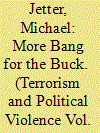

|
|
|
|
|
| Summary/Abstract |
This paper provides empirical evidence that suicide attacks systematically draw more media attention than non-suicide terrorist attacks. Analyzing 60,341 terrorist attack days in 189 countries from 1970 to 2012, I introduce a methodology to proxy for the media coverage each one of these attack days receives in the New York Times. Suicide attacks are associated with significantly more coverage. In the most complete regression, one suicide attack produces an additional 0.6 articles—a magnitude equivalent to the effect of 95 terrorism casualties. This link remains robust to including a comprehensive list of potentially confounding factors, fixed effects, and country-specific time trends. The effect is reproduced for alternative print and television outlets (BBC, Reuters, CNN, NBC, CBS), but remains weak for Google Trends (worldwide and in the U.S.), a more direct proxy for people’s interests, and is non-existent for C-SPAN, a television station dedicated to broadcasting political discussions directly. Thus, the media appears to cover suicide missions in an extraordinary fashion, which may in turn explain their prominence among terrorist organizations.
|
|
|
|
|
|
|
|
|
|
|
|
|
|
|
|
| 13 |
ID:
169922


|
|
|
|
|
| Summary/Abstract |
Whereas cocaine kingpins are often portrayed as key protagonists and perpetrators of violence in Latin America, in Peru’s Upper Huallaga they are also important powerholders who have formed dynamic systems of governance by dominating socio-economic resources and legitimating their narco-territoriality through arrangements with a variety of “shadow powers.” Although potentially violent armed actors, whether insurgents or the police and military, often abound in these “dangerous places,” in the post-conflict Upper Huallaga most of these groups aimed to gain more power and control by forming coalitions with the local powerholders. Drawing upon the narratives of drug barons, traffickers and producers, insurgents, and state officers, this article seeks to focus on an aspect that is largely overlooked in other analyses: the intricate relationship between contested narco-territoriality, weakening local governance networks, and “new” outbreaks of violence.
|
|
|
|
|
|
|
|
|
|
|
|
|
|
|
|
| 14 |
ID:
169931
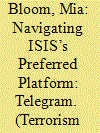

|
|
|
|
|
| Summary/Abstract |
Islamic State in Iraq and Syria (ISIS) online recruitment has been the subject of considerable interest by journalists and technology writers, but there has been no scholarly work to date exploring ISIS Telegram channels and chat rooms. Telegram has played an important role in recruitment and coordination in recent ISIS/terror attacks in Europe. Further, Telegram is quickly replacing the group’s online presence on more open platforms such as Facebook and Twitter as these companies aggressively police and shut down ISIS-linked accounts. This research note aims to demystify Telegram, explain how it can be used for research, and discuss some of the addictive qualities associated with user engagement.
|
|
|
|
|
|
|
|
|
|
|
|
|
|
|
|
| 15 |
ID:
169907
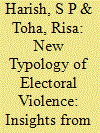

|
|
|
|
|
| Summary/Abstract |
Existing literature on election violence has focused on how violence suppresses voter participation or shapes their preferences. Yet, there are other targets of election violence beyond voters who have so far received little attention: candidates and government agencies. By intimidating rival candidates into dropping out of the race, political hopefuls can literally reduce the number of competitors and increase their likelihood of winning. Likewise, aspiring candidates can target government agencies perceived to be responsible for holding elections to push for electorally beneficial decisions. In this paper, we introduce a new typology of electoral violence and utilize new data of election violence that occur around executive elections in Indonesia from 2005 through 2012. The types of violence we identified differ in these ways: a) Of all cases of electoral violence observed in this article, most incidents were targeted towards candidates and government bodies; b) candidates are generally targeted before elections, whereas voter-targeting incidents are spread out evenly before and after elections and government-targeted violence tends to occur afterwards; c) pre-election violence is concentrated in formerly separatist areas, but post-election violence is more common in districts with prior ethnocommunal violence. These distinctions stress the importance of examining when and why different strategies are adopted.
|
|
|
|
|
|
|
|
|
|
|
|
|
|
|
|
| 16 |
ID:
169924


|
|
|
|
|
| Summary/Abstract |
In the beginning faith was the alpha and omega of revolutionary dreams and terrorist actions. This article will examine case studies among the Peoples of the Book—Judaism, Christianity, and Islam—for religious terrorism is not the product of one faith. It argues that the cultural resonance of each movement examined offers a blank slate on which contemporary seekers, dreamers, and fighters may write. The title, borrowed from a popular novel, is the leitmotif of this form of violence. By all objective forms of analysis, the movements chronicled in these pages are a parade of seemingly stupid ideas held by idealists, fools, and fanatics who dreamed that, with God at their side, they could bring perfection to a fallen world. In such a cause, antinomian violence is inevitable and genocide its logical outcome. Yet these early movements are not to be despised, for together it was they, not the huddled masses cowering before the powers that be, that created the modern world.
|
|
|
|
|
|
|
|
|
|
|
|
|
|
|
|
| 17 |
ID:
169921
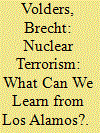

|
|
|
|
|
| Summary/Abstract |
The international security community is increasingly concerned about the nexus between indiscriminate terrorism and the proliferation of nuclear technology and materials. Many nuclear terrorism threat assessments focus primarily on terrorist motivations to employ an atomic bomb, the availability of nuclear know-how and technology, and the opportunity for clandestine organisations to acquire fissile material. Scholars and experts, however, often neglect to elaborate on the challenges for terrorist organisations in organising and implementing the construction and detonation of a crude atomic bomb. This will most likely be a complex project. This article will therefore explore the organisation of such an endeavour. To be precise, we will highlight the impact of the organisational design of the terrorist group. The organisational design determines the division of tasks and how coordination is achieved among these tasks. It therefore has a strong impact on the functioning of any organisation, especially an innovative and complex terrorism project. Building on a case study of Los Alamos, we inductively infer that terrorist organisations face an inherent effectiveness-efficiency trade-off in designing a nuclear armament project.
|
|
|
|
|
|
|
|
|
|
|
|
|
|
|
|
| 18 |
ID:
169934
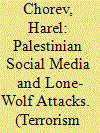

|
|
|
|
|
| Summary/Abstract |
This article examines the impact of social media on the wave of Palestinian lone-wolf attacks against Israelis from October 2015 through September 2016. My principal argument is that social media played an important role in shaping the identity, perceptions, and behavioral patterns of dozens of assailants, and was key in creating the dynamic that ultimately characterized both the spreading of the idea of lone-wolf attacks and its execution. Social media reflected reality on the ground while simultaneously nourishing, amplifying, and escalating the situation by providing a platform for the emergence of new sources of authority, including an online subculture with distinct codes and pseudo-ritual patterns to support assailants. Social media also contributed substantially to shaping the contagious character of the attacks, and their capacity to persist without direct organizational guidance, following a typical epidemiological dynamic of spread, containment, and preservation.
|
|
|
|
|
|
|
|
|
|
|
|
|
|
|
|
| 19 |
ID:
169917


|
|
|
|
|
| Summary/Abstract |
This paper applies the distance-to-crime approach to the case of Improvised Explosive Device (IED) and shooting attacks conducted by the Provisional Irish Republican Army (PIRA) during the Northern Ireland conflict, 1970–1998. The aim is to (a) measure the typical ‘distance to crime’ (b) detect whether a distance-decay effect is noticeable and (c) investigate whether there is a discernible difference in the distance traveled depending upon individual offender characteristics or aspects of how the offence was committed. In particular, it highlights that many of the same dynamics that influence offender decision making within the volume crime world, also apply within the terrorism realm. Five findings stand out in particular. First, a distance decay effect is identifiable. Second, younger offenders travel significantly smaller distances. Third, complex attacks typically involve greater distances. Fourth, our results show the ability of leading decision-makers within PIRA to impact upon the day-to-day operations of the field operatives. Together the results reinforce the argument that when we focus on terrorism from a preventative angle, we should focus on their behaviors: what they do rather than remain preoccupied with concerns about who they are and/or what they might be like. Collectively the results also highlight the fact that for a finer-grained understanding of terrorist behavior we need to disaggregate on a number of levels: within the cadre of operatives, across terrorist attacks, across targets and within conflicts.
|
|
|
|
|
|
|
|
|
|
|
|
|
|
|
|
| 20 |
ID:
169927
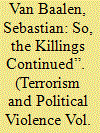

|
|
|
|
|
| Summary/Abstract |
Many post-war states experience continuous low-intensity violence for years after the formal end of the conflict. Existing theories often focus on country-level explanations of post-war violence, such as the presence of spoilers or the nature of the peace agreement. Yet, post-war violence does not affect all communities equally; whereas some remain entrenched in violence, others escape the perpetuation of violent conflict. We argue that communities where wartime mobilization at the local level is based on the formation of alliances between armed groups and local elites are more likely to experience post-war violence, than communities where armed groups generate civilian support based on grassroots backing of the group’s political objectives. We explore this argument in a comparison of three communities in KwaZulu-Natal, South Africa, which have experienced different levels of post-war violence. The analysis supports the main argument and contributes to the research on the microdynamics of civil war by outlining the implications of certain strategies of wartime mobilization and how these may generate localized legacies.
|
|
|
|
|
|
|
|
|
|
|
|
|
|
|
|
|
|
|
|
|